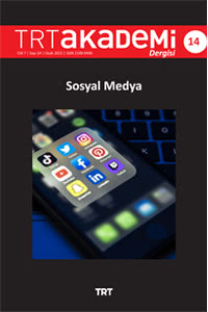“Gördüğün Her Şeye İnanma”: Derin Sahte Çalışmaları Üzerine Bir Doküman Analizi
Derin Sahte, Yapay Zekâ, İletişim, Medya, Yalan Haber
“Do Not Believe Everything You See”: A Document Analysis on Deep Fake Studies
Deep Fake, Artificial Intelligence, Communication, Media, Fake News,
___
- Ajaka, N., Samuels, E., & Kessler, G. (2019). The Washington Post’s guide to manipulated video. TheWashington Post.
- Allen, J., Howland, B., Mobius, M., Rothschild, D., & Watts, D. J. (2020). Evaluating the fake news problem at the scale of the information ecosystem. Science Advances, 6 (14), 1–6.
- Anderson, C. (2019). A new hermeneutics of suspicion? The challenge of deepfakes to theological epistemology. Cursor_ Zeitschrift Für Explorative Theologie.
- Asimov, İ. (2016). Ben Robot (E. Odabaş, Çev.). İstanbul: İthaki Yayınları.
- Baudrillard, J. (2003). Simülakrlar ve Simülasyon (O. Adanır, Çev.). Ankara: Doğu Batı Yayınları.
- Benjamin, W. (2015). Teknik Olarak Yeniden-Üretilebilirlik Çağında Sanat Yapıtı (G. Sarı, Çev.). İstanbul: Zeplin Yayınları.
- Berk, M. E. (2020). Dijital çağın yeni tehlikesi “deepfake”. OPUS–Uluslararası Toplum Araştırmaları Dergisi, 16(28), 1508-1523.
- Citron, D. K. & Chesney, R. (2018). Deep fakes: a looming challenge for privacy, democracy, and national security. California Law Review, Vol. 107, 1753–1820.
- Citron, D. K., & Chesney, R. (2019). 21st century-style truth decay: Deep fakes and the challenge for privacy, free expression, and national security. Maryland Law Review, Vol.78(4), 882–891.
- Demircan, B. (2020). Politik öznenin özneleşen yeni medya ile ikilemi. İçinde: Yeni Medya, Toplum ve Siyasal İletişim (H. Hülür ve C. Yaşin, Ed.). Ankara: Ütopya Yayınları.
- Ellul, J. (2003). Teknoloji ve Toplum (M. Ceylan, Çev.). İstanbul: Bakış Yayınları.
- İnam, A. (2019). Ahmet İnam ile Söyleşi: İnsanı Tanımak için Yapay Zekâ: Sahici İnsan ve Bir Yaşam Tarzı Olarak Felsefe. Yapay Zekâ ve Zihin Felsefesi Dergisi. 2/2, 137-158.
- Kaplan, A. & Haenlein, M. (2018). Siri, Siri, in my hand: Who’s the fairest in the land? On the interpretations, illustrations, and implications of artificial intelligence. Business Horizons, 62 (1), 15-25.
- Godulla, A., Hoffmann, P. C. & Seibert, D. (2021). Dealing with deepfakes an interdisiplinary examination of the state of research and implications for communication studies. Studies in Communication and Media. 10/1, 72-96.
- Khodabakhsh, A., Ramachandra, R., & Busch, C. (2019). Subjective evaluation of mediaconsumer vulnerability to fake audiovisual content. IEEE 11th International Conference on Quality of Multimedia Experience, 1–6.
- Maras, M.-H. & Alexandrou, A. (2019). Determining authenticity of video evidence in theage of artificial intelligence and in the wake of deepfake videos. The International Journal of Evidence & Proof, Vol. 23(3), 255–262.
- Marshall, G. (1999). Sosyoloji Sözlüğü. Ankara: Bilim Sanat Yayınları.
- Muller, P. & Denner, N. (2017). What to do against fake news? An analysis based on the conditions under which fake news originates and the effects of targeted false reports on the Internet. Berlin: Friedrich Naumann Stiftungfur die Freiheit.
- Silbey, J. & Hartzog, W. (2019). The upside of deep fakes. Maryland Law Review, 78, 960-966.
- Sunal, G & Kara, A . (2021). Sen hep gülümse reklam filminin göstergebilimsel çözümlemesi üzerinden eleştirel bir değerlendirme. İnönü Üniversitesi İletişim Fakültesi Elektronik Dergisi (İNİF E-Dergi). 6/1, 79-102.
- Süslü, A. (2019). Doğa ve insan bilimlerinde yapay zekâ uygulamaları. Akedemia Doğa ve İnsan Bilimleri Dergisi. 5/1, 1-10.
- Tamer, H. S. ve Övgün, V. (2020). Yapay zekâ bağlamında dijital dönüşüm ofisi. SBF Dergisi. 75/2, 775-803.
- Tandoc Jr, E. C., Lim, Z. W., & Ling, R. (2018). Defining “fake news”: A typology of scholarly definitions. Digital journalism, 6(2), 137–153.
- Temir, E. (2020). Deepfake: New Era in The Age of Disinformation & End of Reliable Journalism . Selçuk İletişim Dergisi, 13 (2), 1009-1024 .
- Tsfati, Y., Boomgaarden, H. G., Stromback, J., Vliegenthart, R., Damstra, A., & Lindgren,
- E. (2020). Causes and consequences of mainstream media dissemination of fake news: literatüre review and synthesis. Annals of the International Communication Association. 44(2), 1–17.
- Vaccari, C. & Chadwick, A. (2020). Deepfakes and disinformation: exploring the impact of synthetic political video on deception, uncertainty, and trust in news. Social Media+ Society, 6 (1), 1–13.
- Wardle, C. & Derakhshan, H. (2017). Information disorder: toward an interdisciplinary framework for research and policy making. Council of Europe report, 27.
- Westerlund, M. (2019). The emergence of feepfake technology: a review. Technology Innovation Management Review. 9/11, 39–52.
- Vizoso, A. (2021). Fighting Deepfakes: Media and Internet Giants’ Converging and DivergingStrategies Against Hi-Tech Misinformation. Media and Communication. 9/1, 291-300.
- Yadav, D. & Salmani, S. (2019). Deepfake: a survey on facial forgery technique using generative adversarial network. IEEE International Conference on Intelligent Computing and Control Systems, Mayıs, 852–857.
- ISSN: 2149-9446
- Yayın Aralığı: 3
- Başlangıç: 2016
- Yayıncı: TRT
Cahit Arf’in “Makine Düşünebilir mi ve Nasıl Düşünebilir?” Adlı Makalesi Üzerine Bir Çalışma
Ahlaki Değerlerin Kodlanabilmesi Bağlamında Yapay Zekâ Etiğine Kuramsal Bir Bakış
İletişim Çalışmalarında Yapay Zekâ: 1982-2021 Yılları Arasındaki Çalışmalara Yönelik Bir İnceleme
Süper Zekâ: Yapay Zekâ Uygulamaları, Tehlikeler ve Stratejiler
Hard Bilim Kurgu Usulü Humanoid Robot Tanımı
Yapay Zekâ ve Özgür İrade: Yapay Özgür İradenin İmkânı
Makine Merkezli Kamu Diplomasisinde Etik ve Etki Sorunsalı
